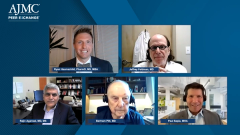
Blood Pressure Management Within the CKD Treatment Landscape
Drs Agarwal and Pitt begin an overview of the CKD treatment landscape, beginning with the importance of blood pressure management.
Episodes in this series

Ryan Haumschild, PharmD, MS, MBA: Dr Agarwal, I’d like you to talk about the treatment landscape for patients with CKD [chronic kidney disease], specifically focusing on blood pressure management. Do you mind chiming in with your thoughts on managing blood pressure in this patient population?
Rajiv Agarwal, MD, MS: All guidelines say the same thing. If you have albuminuria, you have to start with ACE inhibitors or ARBs. That’s the backbone, but there are a substantial number of people who won’t tolerate these drugs because of hyperkalemia or because they’re intolerant to it. For example, they develop a cough or angioedema. Things like that can happen. But ACEs and ARBs are the backbone. It turns out that only a fraction of people in United States with more advanced kidney disease are on ACEs or ARBs, so we aren’t really following guideline-based therapy.
Once the ACEs and ARBs are on board, we have to get the blood pressure down other ways. Most people with chronic kidney disease need 3, 4, or 5 drugs to get the blood pressure down. We’re basically dealing with polypharmacy. Dihydropyridine calcium channel blockers are effective. Beta-blockers are effective. What we found more recently that’s challenging the paradigm in people with GFR [glomerular filtration rate] less than 30 mL/min is we used to think that you needed to use loop diuretics. In a randomized double-blind trial, we found that chlorthalidone was pretty effective in reducing blood pressure. It reduced 10.5 mmHg systolic based on ambulatory blood pressure monitoring in stage 4 kidney disease. These findings were part of the CLICK trial. It was all limited to patients with stage 4 kidney disease and was published in the New England Journal of Medicine.
We have to throw the kitchen sink at these patients to get the blood pressure down. One thing that’s often overlooked in these patients is lifestyle modifications. For example, dietary sodium restriction, weight loss, smoking cessation, and exercise can all have additional value. In some people, moderation of alcohol intake or cessation of alcohol intake can be quite valuable. Those would be the approaches I’d take in treating these patients, and especially not prescribe people a drug that’s taken 3 times a day. Use once a day and use combination therapy, where you have 2 or 3 drugs in 1 pill, rather than giving separate pills and making it complicated. For example, I almost never use hydralazine 3 times a day because nobody can take a lifelong pill 3 times a day. That’s the approach that I suggest.
Ryan Haumschild, PharmD, MS, MBA: Excellent. That was a great overview and a great management technique. Dr Pitt, you’re our cardiologist here. Do you have anything additional to add to what Dr Agarwal mentioned?
Bertram Pitt, MD: Dr Agarwal touched on a number of important points, and others talked about obesity, but we’re learning that obese patients have an increase in aldosterone. We know that if you don’t control the aldosterone, it contributes to progression of heart disease and kidney disease. We know that if you use a mineralocorticoid receptor antagonist in people with hypertension, you get a more substantial drop in blood pressure.
Dr Agarwal mentioned chlorthalidone, which is very effective, but it’s also been seen that when you use chlorthalidone, you increase aldosterone levels. If you don’t counteract the effects of aldosterone, there’s a progression of disease and it gets even more complicated. We thought primary aldosteronism was in only a small percentage of people with essential hypertension. Now there are more data, suggesting maybe 30% or even 40% of people with essential hypertension. You can control blood pressure with a calcium blocker, an ACE, or an ARB, but if you don’t block the underlying aldosterone, you still have 3 times progression of risk and disease. Counteracting the effects of aldosterone in many contexts is becoming more important. We now have new drugs that seem to be much safer than our old friends, such as spironolactone, that we’ve all grown up with but became wary of because of intolerance.
Ryan Haumschild, PharmD, MS, MBA: Excellent. Dr Agarwal, you finished this question, but do you have any additional comments?
Rajiv Agarwal, MD, MS: Dr Pitt has been a leader with spironolactone with his trials, and he makes very important points. Because we’re dealing with a patient with kidney disease and management of hypertension, we have to be a little cautious. We did a trial in patients with resistant hypertension. All of them had a GFR of less than 45 mL/min, so GFR between 25 and 45 mL/min. We randomized them to getting spironolactone with patiromer or spironolactone alone. We found that 2 of 3 people became hyperkalemic within 12 weeks. That means a potassium of 5.5 mEq/L or higher. Even when they got patiromer, 1 of 3 became hyperkalemic within 12 weeks. Hyperkalemia is a real risk, and you have a lack of persistence. There’s no question that we need additional studies to look at it.
As far as chlorthalidone is concerned, we found that there was a 50% reduction in urine albumin-to-creatine ratio, much larger than you see with spironolactone use within 4 weeks. It turns out that when you follow these patients long term for several years, the point estimate of the hazard ratio for end-stage kidney disease or death is 0.68, which is reduced. The upper bounds of the confidence intervals us 1.13, so it isn’t statistically significant, but you can’t look at statistical significance in a 160-patient study. Nonetheless, what Dr Pitt is pointing out is that we shouldn’t forget spironolactone. I completely agree. That’s an area that should be researched further.
Transcript edited for clarity.
Newsletter
Stay ahead of policy, cost, and value—subscribe to AJMC for expert insights at the intersection of clinical care and health economics.





























































